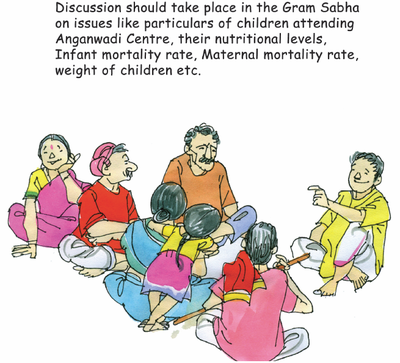PANCHAYATI RAJ SYSTEM TOWARDS CHANGING RURAL INDIA
Relevance:
Sociology:
Politics and Society:
- Regionalism and decentralization of power.
G.S paper: II:
- Governance
Introduction:
- The Father of the Nation Mahatma Gandhi advocated Panchayati Raj as the foundation of India’s political system where a decentralised form of governance structure is established at each village. He advocated the empowerment of panchayats for the development of rural areas.
- Recognising the importance of panchayats, the Constitution makers included the provision of panchayats in Part IV (Directive Principles of State Policy) of the Indian Constitution. Article 40 of the Constitution conferred the responsibility upon the State to take steps to organise village panchayats and endow them with such power and authority as may be necessary to enable them to function as units of self-government.
Important committees:
- The formal organisations and structure of Panchayati Raj were first recommended by the Balwant Rai committee. It recommended the establishment of the scheme of democratic decentralisation, which ultimately came to be known as Panchayati Raj.
- Rajasthan (Nagaur district) became the first state to introduce the panchayat system in India.
- In 1977, the Ashok Mehta Committee on Panchayati Raj recommendations included a two-tier system of the panchayat, regular social audit, representation of political parties at all levels of panchayat elections, provisions for a regular election, reservation to SCs/STs in panchayats and a minister for Panchayati Raj in the state council of ministers.
- In 1985, G.V.K. Rao Committee recommended measures to strengthen Panchayati Raj institutions (PRIs). For the first time, it recommended a constitutional status of PRIs.
- The 73rd Constitutional Amendment Act, 1992, conferring constitutional status to PRIs came into force in 1993.
73rd Amendment Act, 1992:
- A new Part-IX to the Constitution was added under the 73rd Amendment enacted in 1992.
Article 243G of the Constitution intended to empower the Gram Panchayats (GPs) by enabling the State Governments to devolve powers and authority in respect of all 29 Subjects listed in the Eleventh Schedule for local planning and implementation of schemes for economic development and social justice..jpg)
Key provisions:
- PRIs were established as a three-tier structure based on direct elections at all three tiers – village (Gram Panchayat), intermediate (Panchayat Samiti) and district (Zila Parishad). Exemption from the intermediate tier is given to the small States having less than 20 lakh population.
- The functions which could be devolved to PRIs include preparing plans for economic development and social justice, schemes of economic development and social justice with regard to 29 important matters mentioned in the XI Schedule such as agriculture, primary and secondary education, health and sanitation, drinking water, rural housing, the welfare of weaker sections, social forestry, etc.
- Most of these posts at three levels are to be filled by direct elections.
- The minimum age for contesting elections to the PRIs is 21 years.
- Only the post of Chairman at the District and Block levels should be filled by indirect elections.
- There is provision for reservation of seats for Scheduled Castes and Scheduled Tribes in Panchayats proportion to their population, and for women in Panchayats up to one-third of seats.
- State Election Commission to be set up in each State to conduct elections to PRIs.
- The tenure of PRIs is five years.
- Creation of a State Finance Commission in each state every five years.
- Guidelines giving representation to the members of Central and State legislatures in the district and middle-level PRIs, provisions of reservation for backward classes and financial powers to PRIs such as taxes, levy fees, etc. are not mandatory and are left to the states to choose to implement or not.
Significance of PRIs:
- Since getting constitutional status in 1992, PRIs have played a critical role in the development process of the villages. With the government relying more and more on PRIs for the implementation of mega-development programmes, PRIs have cemented their position in the rural governance structure.
- The Panchayati Raj Institutions (PRls) have taken major responsibilities of playing a critical role in implementing mega schemes of the government while ensuring people’s participation in the governance structure of the villages.
Initiatives being taken:
Devolution of Funds, Function and Functionaries to PRIs:
- The funds, function and functionaries that form the three main components of the devolution of power vary across states. A devolution report published by the Ministry of Panchayati Raj in 2015-16 stated that devolution has two main aspects: the operational core that includes funds, function, functionaries, and the support system that includes capacity building of PRIs, operationalizing constitutional mechanisms and introducing systems of transparency and accountability.
- As per Article 280 (30) (bb) of the Constitution, the Union Finance Commission would recommend measures to supplement the resources of the Panchayats in the state on the basis of the recommendation of the Finance Commission of the State.
Rising Financial Devolution to PRIs:
- For the period FY 2020-21, the Fifteenth Finance Commission has awarded a grant of Rs. 60,750 crore, for Rural Local Bodies (RLBs) in 28 states which is the highest annual Finance Commission allocation for the RLBs so far.
- The government has initiated several measures such as incentivising the states which have devolved more functions, funds and functionaries to PRIs, providing financial and technical assistance for capacity building to PRIs to enable them to perform the devolved functions effectively and strengthening systems of budgets, accounting and auditing for bringing in transparency, accountability and efficiency in the functioning of PRIs.
Important schemes:
- Unified e-GramSwaraj Portal and mobile application and Svamitva scheme have been implemented.
- The e-GramSwaraj portal helps prepare and execute Gram Panchayat Development Plans. The portal will ensure real-time monitoring and accountability and marks a major step towards digitization down to the Gram Panchayat level.
- The Svamitva scheme helps to map rural inhabited lands using drones and the latest survey methods. The scheme will ensure streamlined planning, revenue collection and provide clarity over property rights in rural areas.


